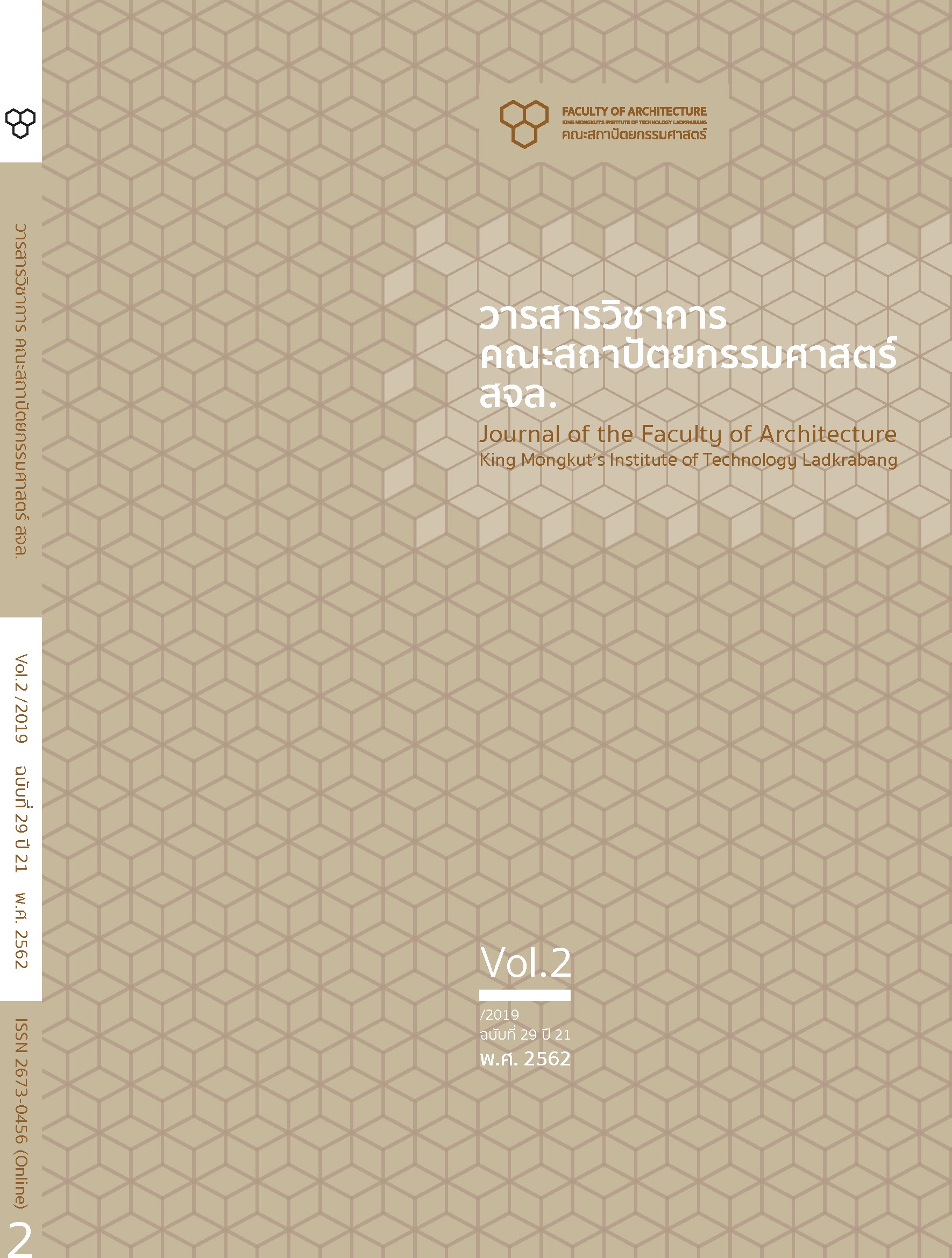The Study of Temperature from Heat Transfer through Building Envelopes to Design Guidelines and Renovation High-performance Wall for Thai Lanna Vernacular Houses in Hot-humid Climate
Main Article Content
Abstract
บทคัดย่อ
เรือนไทยพื้นถิ่นเป็นสถาปัตยกรรมไทยที่หาดูได้ยากและทรงคุณค่าแก่การอนุรักษ์เป็นมรดกทางวัฒนธรรม ซึ่งปัจจุบันอาจไม่เหมาะสมต่อการอยู่อาศัยจริง เนื่องจากสภาพแวดล้อมมี อุณหภูมิเพิ่มสูงขึ้นกว่าเกณฑ์สบายของมนุษย์ ตลอดทั้งปี การสำรวจกลุ่มตัวอย่างเรือนไทยพื้นถิ่นล้านนา พบว่าการเปลี่ยนแปลงอุณหภูมิ อากาศภายในตัวเรือน เกิดจากการแผ่รังสีความร้อนของผิววัสดุผนังโดนแดด เพดาน และพื้นมีระดับอุณหภูมิผิวเฉลี่ยสูงกว่าอุณหภูมิอากาศทั่วไป 4.5 °C และ 1.1 °C ตามลำดับส่งผลต่อการเพิ่มขึ้นของอุณหภูมิอากาศภายในตัวเรือนที่สูงกว่าอุณหภูมิอากาศภายนอก 3.4 °C งานวิจัยนี้มีวัตถุประสงค์ที่จะลดการถ่ายเทความร้อนผ่านวัสดุผนังไม้ เพื่อควบคุมอุณหภูมิอากาศภายในให้ใกล้เคียงสภาวะน่าสบายของมนุษย์ กระบวนการวิจัยได้มีการเก็บข้อมูลอุณหภูมิผิววัสดุผนังไม้ เพดานไม้ และพื้นไม้ ตลอด 24 ชั่วโมง เพื่อวิเคราะห์ การถ่ายเทความร้อนผ่านกรอบอาคาร และออกแบบ-ปรับปรุงผนังเพื่อลดการแผ่รังสี ความร้อนจากผิววัสดุ ประเมินผลการใช้พลังงานจากระบบปรับอากาศ ผลวิจัยพบว่า วัสดุไม้ที่ใช้ทำฝาผนัง เพดาน และพื้นมี ความหนา 3/4” 1” และ 1.5” ตามลำดับ มีค่าความจุความร้อนของวัสดุต่ำ วัสดุไม่มีความสามารถในการหน่วงความร้อน ส่งผลให้อุณหภูมิผิววัสดุสูงกว่า อุณหภูมิอากาศและถ่ายเทสู่ตัวเรือนที่มีอุณหภูมิต่ำกว่าโดยการแผ่รังสีความร้อน การออกแบบ-ปรับปรุงผนังให้มีประสิทธิภาพการป้องกันความร้อน ควรเพิ่มวัสดุที่มีคุณสมบัติ ต้านทานความร้อน ระหว่างช่องว่างโครงสร้างไม้ เช่น ฉนวนกันความร้อน โฟม และปิดทับด้วยแผ่นยิปซั่มบอร์ดจะช่วยให้อุณหภูมิผิวภายในลดลง ลดการถ่ายเทความร้อนผ่านกรอบ อาคารเทียบเท่าแอร ์ 7,522 Btu/hr อุณหภูมิ อากาศภายในตัวเรือนใกล้เคียงเกณฑ์สบายของมนุษย์ ภาระการทำความเย็นของระบบปรับอากาศลดลง 87% จะเห็นได้ว่าการปรับปรุงผนังประสิทธิภาพสูงสามารถลดอิทธิพลการแผ่รังสี ความร้อน จากผิววัสดุ และมีความเหมาะสมต่อการอยู่อาศัยจริงของมนุษย์ภายใต้สภาพแวดล้อมเขตร้อนชื้นยุคปัจจุบันเพิ่มมากขึ้น รวมทั้งสามารถต่อยอดสู่การออกแบบ-ปรับปรุงเรือนไทยพื้นถิ่นในภูมิภาคอื่นได้
คำสำคัญ: เรือนไทยพื้นถิ่นล้านนา ผนังประสิทธิภาพสูง การถ่ายเทความร้อน ออกแบบ-ปรับปรุง
Abstract
Thai vernacular architecture is considered as a rare and valuable Thai cultural heritage. Nowadays, the Thai vernacular forms and materials are no longer suitable for today context and living conditions. The increase in average air temperature in a year-round condition is above an average human comfort zone. The survey of Thai-Lanna vernacular houses found that the impact of indoor air temperature change is caused by heat radiation through surface material of wall, ceiling and floor. This makes the average surface temperature higher than outside air temperature by 4.5 oC and 1.1 oC, respectively. As result, inside air temperature is 3.4 oC higher than outside air temperature. This study aims to reduce heat transfer from wood walls in order to control inside air temperature as to approach the human comfort zone. The research method comprised 1) collecting data of surface temperatures of wall, ceiling and floor, over a 24-hour period and analyzing heat transfer through building envelope in each time period, 2) designing building envelope materials to reduce effects of heat transfer, and 3) evaluating energy used in the cooling load of the air conditioning systems. The study found that wood walls, 3/4”, 1” and 1.5” thick, have low specific heat capacity. The wood material is unable to cause a heat lag, causing inside surface temperature to be higher than outside air temperature, and heat transfer into the house through radiation. The design of high-performance wall should add materials with higher heat resistance between wood structure. Using insulation and gypsum can help to reduce heat transfer equivalent to air conditioners by 7,522 Btu/hr. Indoor air temperature reached reach the human comfort zone and cooling load decreased by 87%. Thus, high-performance wall for Thai vernacular houses is suitable for the present living condition in hot-humid climate.
Keywords: Thai Lanna Vernacular Houses, High-performance Wall, Heat Transfer, Design-renovation
Article Details
This work is licensed under a Creative Commons Attribution-NonCommercial-ShareAlike 4.0 International License.
Copyright Transfer Statement
The copyright of this article is transferred to Journal of The Faculty of Architecture King Mongkut's Institute of Technology Ladkrabang with effect if and when the article is accepted for publication. The copyright transfer covers the exclusive right to reproduce and distribute the article, including reprints, translations, photographic reproductions, electronic form (offline, online) or any other reproductions of similar nature.
The author warrants that this contribution is original and that he/she has full power to make this grant. The author signs for and accepts responsibility for releasing this material on behalf of any and all co-authors.
References
ชญาณิน จิตรานุเคราะห์. (2550). การวิเคราะห์สาระสำคัญของเทคโนโลยีเรือนไทยภาคกลาง. (วิทยานิพนธ์ดุษฎีบัณฑิต คณะสถาปัตยกรรมศาสตร์, จุฬาลงกรณ์มหาวิทยาลัย).
วุฒิกานต์ ปุระพรหม. (2559). อิทธิพลขององค์ประกอบรอบที่ตั้งต่อการเปลี่ยนแปลงอุณหภูมิอากาศภายนอกในสภาพแวดล้อมเขตร้อนชื้น. (วิทยานิพนธ์ปริญญาดุษฎีบัณฑิตภาควิชาสถาปัตยกรรมศาสตร์ บัณฑิตวิทยาลัย, จุฬาลงกรณ์มหาวิทยาลัย).
สุนทร บุญญาธิการ. (2542). เทคนิคการออกแบบบ้านประหยัดพลังงานเพื่อคุณภาพชีวิตที่ดีกว่า. กรุงเทพมหานคร: โรงพิมพ์จุฬาลงกรณ์มหาวิทยาลัย.
สุนทร บุญญาธิการ, วรสัณฑ์ บูรณากาญจน์, รวิช ควรประเสริฐ, ณรงค์ฤทธิ์ จินต์จันทรวงค์, สุธีวัน โล่ห์สุวรรณ และนัฐพล จิรัฐติกาลกิจ. (2554). โครงการออกแบบเพื่อกายภาพบำบัดและสร้างดัชนีระบบนิเวศ. กรุงเทพมหานคร: สำนักงานคณะกรรมการวิจัยแห่งชาติ.
สำนักส่งเสริมศิลปวัฒนธรรม มช. (2016). พิพิธภัณฑ์เรือนโบราณล้านนา. เข้าถึงได้จาก: https://art-culture.cmu.ac.th/gallery.php?gal_type=2.
อรศิริ ปาณินท์. (2546). ความแปรเปลี่ยนของเรือนและสภาพแวดล้อมพื้นถิ่น ในภูมิปัญญาสถาปัตยกรรม. (หน้า 32-65). กรุงเทพฯ: ศูนย์ตำราและเอกสารวิชาการ คณะสถาปัตยกรรมศาสตร์ จุฬาลงกรณ์มหาวิทยาลัย.
ASHRAE (2007). Energy Standard for Buildings Except Low-rise Residential Buildings (I-P Edition). Atlanta: ASHRAE.
Bowring, J. (1969). The Kingdom and People of Siam. London: Oxford University Press.
Puraprom, W. (2018). Design Guidelines for Model Educational Building for Energy Conservation According to Green University. Journal of Architectural/Planning Research and Studies. 15(2), 107-120.
Puraprom, W. (2016). The Impact of Site Elements to Micro-Climate Air Temperature. Journal of Architectural/Planning Research and Studies. 13(1), 23-34.
Stein, B. and Reynolds, J. S. (2000). Mechanical and Electrical Equipment for Buildings. 9th ed. New York: John Wiley & Sons.


